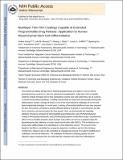| dc.contributor.author | Hong, Jinkee | |
| dc.contributor.author | Alvarez, Luis M. | |
| dc.contributor.author | Shah, Nisarg J. | |
| dc.contributor.author | Cho, Younghyun | |
| dc.contributor.author | Kim, Byeong-Su | |
| dc.contributor.author | Char, Kookheon | |
| dc.contributor.author | Griffith, Linda G | |
| dc.contributor.author | Hammond, Paula T | |
| dc.date.accessioned | 2015-10-20T19:46:24Z | |
| dc.date.available | 2015-10-20T19:46:24Z | |
| dc.date.issued | 2012-09 | |
| dc.identifier.issn | 2190-393X | |
| dc.identifier.issn | 2190-3948 | |
| dc.identifier.uri | http://hdl.handle.net/1721.1/99375 | |
| dc.description.abstract | The promise of cellular therapy lies in healing damaged tissues and organs in vivo as well as generating tissue constructs in vitro for subsequent transplantation. Postnatal stem cells are ideally suited for cellular therapies due to their pluripotency and the ease with which they can be cultured on functionalized substrates. Creating environments to control and successfully drive their differentiation toward a lineage of choice is one of the most important challenges of current cell-based engineering strategies. In recent years, a variety of biomaterials platforms have been prepared for stem cell cultures, primarily to provide efficient delivery of growth or survival factors to cells and a conductive microenvironment for their growth. Here, we demonstrate that repeating tetralayer structures composed of biocompatible poly(methacrylic acid), poly(acrylamide), and poly(ethylene oxide)-block-poly(ε-caprolactone) micelles arrayed in layer-by-layer films can serve as a payload region for dexamethasone delivery to human mesenchymal stem cells (MSCs). This architecture can induce MSC differentiation into osteoblasts in a dose-dependent manner. The amount of Dex loaded in the films is controlled by varying the deposition conditions and the film thickness. Release of Dex is tuned by changing the amount of covalent cross-linking of multilayers via thermal treatments. The multilayer architecture including payload and cell-adhesion region introduced here are well suited for extended cell culture thus affording the important and protective effect of both Dex release and immobilization. These films may find applications in the local delivery of immobilized therapeutics for biomedical applications, as they can be deposited on a wide range of substrates with different shapes, sizes, and composition. | en_US |
| dc.description.sponsorship | Singapore-MIT Alliance for Research and Technology | en_US |
| dc.description.sponsorship | Hertz Foundation | en_US |
| dc.language.iso | en_US | |
| dc.publisher | Springer-Verlag | en_US |
| dc.relation.isversionof | http://dx.doi.org/10.1007/s13346-012-0093-z | en_US |
| dc.rights | Creative Commons Attribution-Noncommercial-Share Alike | en_US |
| dc.rights.uri | http://creativecommons.org/licenses/by-nc-sa/4.0/ | en_US |
| dc.source | PMC | en_US |
| dc.title | Multilayer thin-film coatings capable of extended programmable drug release: application to human mesenchymal stem cell differentiation | en_US |
| dc.type | Article | en_US |
| dc.identifier.citation | Hong, Jinkee, Luis M. Alvarez, Nisarg J. Shah, Younghyun Cho, Byeong-Su Kim, Linda G. Griffith, Kookheon Char, and Paula T. Hammond. “Multilayer Thin-Film Coatings Capable of Extended Programmable Drug Release: Application to Human Mesenchymal Stem Cell Differentiation.” Drug Deliv. and Transl. Res. 2, no. 5 (September 18, 2012): 375–383. | en_US |
| dc.contributor.department | Massachusetts Institute of Technology. Department of Biological Engineering | en_US |
| dc.contributor.department | Massachusetts Institute of Technology. Department of Chemical Engineering | en_US |
| dc.contributor.department | Massachusetts Institute of Technology. Department of Mechanical Engineering | en_US |
| dc.contributor.department | Koch Institute for Integrative Cancer Research at MIT | en_US |
| dc.contributor.mitauthor | Hong, Jinkee | en_US |
| dc.contributor.mitauthor | Alvarez, Luis M. | en_US |
| dc.contributor.mitauthor | Shah, Nisarg J. | en_US |
| dc.contributor.mitauthor | Kim, Byeong-Su | en_US |
| dc.contributor.mitauthor | Griffith, Linda G. | en_US |
| dc.contributor.mitauthor | Hammond, Paula T. | en_US |
| dc.relation.journal | Drug Delivery and Translational Research | en_US |
| dc.eprint.version | Author's final manuscript | en_US |
| dc.type.uri | http://purl.org/eprint/type/JournalArticle | en_US |
| eprint.status | http://purl.org/eprint/status/PeerReviewed | en_US |
| dspace.orderedauthors | Hong, Jinkee; Alvarez, Luis M.; Shah, Nisarg J.; Cho, Younghyun; Kim, Byeong-Su; Griffith, Linda G.; Char, Kookheon; Hammond, Paula T. | en_US |
| dc.identifier.orcid | https://orcid.org/0000-0003-1727-5732 | |
| dc.identifier.orcid | https://orcid.org/0000-0002-1801-5548 | |
| dc.identifier.orcid | https://orcid.org/0000-0003-3243-8536 | |
| mit.license | OPEN_ACCESS_POLICY | en_US |
| mit.metadata.status | Complete | |
